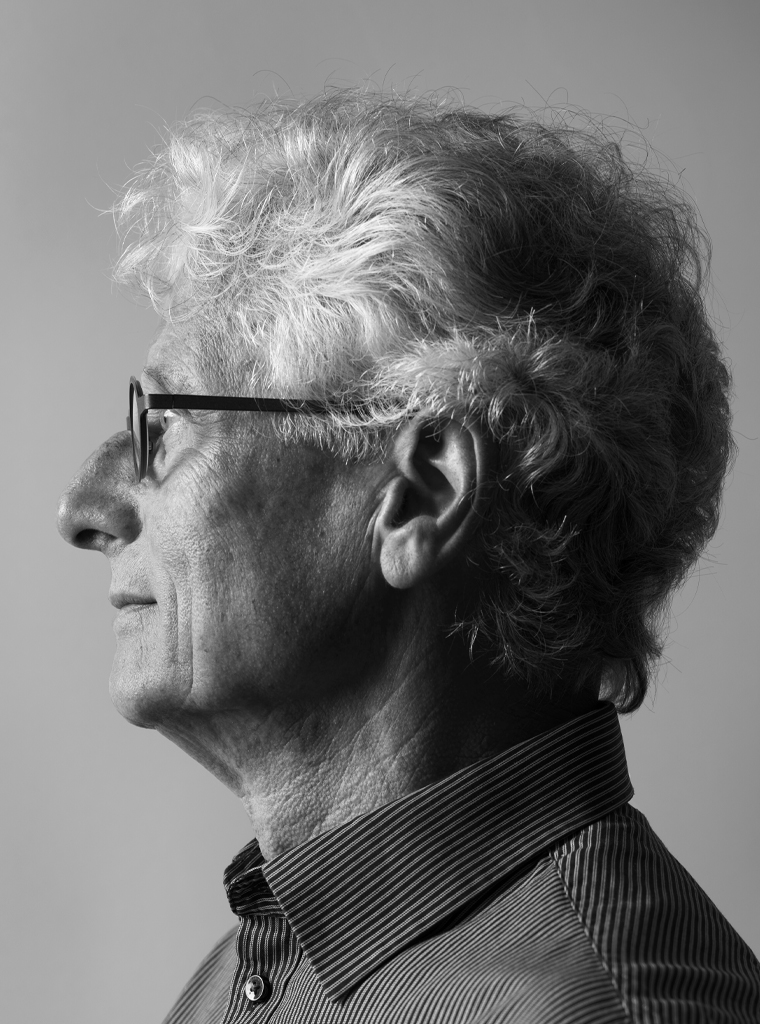Titus Yocarini was born on October 14, 1947 in Amsterdam. His last name is indicative of foreign blood in his ancestry. His grandfather on his father’s side was a tobacco trader who lived on the Greek island of Samos and traveled to visit trade fairs all over Europe. One day, while in The Hague, he met the woman who was to become Titus’s grandmother. They married and went to live on Samos, but grandma got homesick so they returned to the Netherlands.
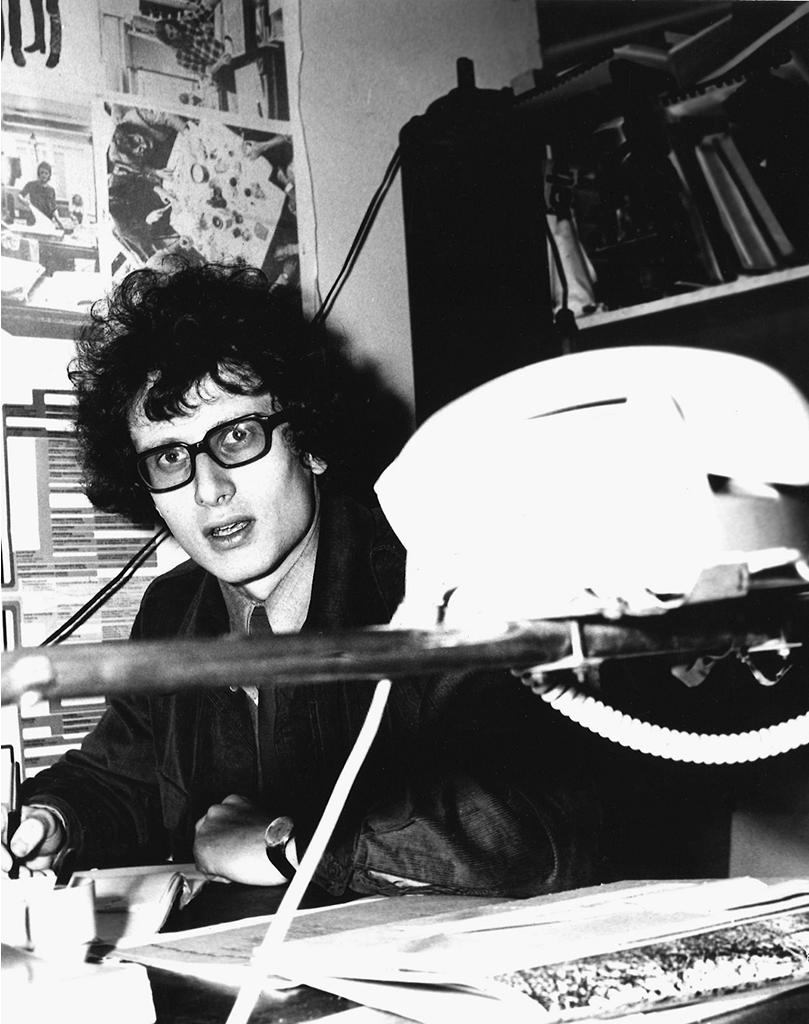
1976. Titus Yocarini at GVN, Keizersgracht 238, Amsterdam (photo: Pieter Boersma)
Titus’ father was the owner of Kloosterman bookstore in Nijmegen. The love of books, publishing, and graphic design entered his life at a young age. He attended St. Canisius College in Nijmegen and published a mimeographed school newspaper, De Mesthoop (The Dunghill), which criticized the education system and put him on the receiving end of quite a few punishments.
Graphic design is what Yocarini wants to study after graduating from high school. He applies for admittance at two art academies. He is accepted at both academies, but the one in Arnhem is closer to Nijmegen and an easy commute by moped, so Arnhem is his choice. The academy still observes a rather bookish approach. “Arriving a little late was immediately punished. Also, it wasn’t much appreciated that a colleague-student and I marched through the corridors while playing the trumpet.” The photography classes taught by Jan Vermeulen and the color exercises of Peter Struycken are inspiring, but he never really feels at home. He decides to drop out.
Yocarini wants to know more about book production and happily enters a half-year of apprenticeship at Drukkerij Thieme in Nijmegen. Dressed in a dustcoat and with a quart of milk on his desk he learns about the ins and outs of typesetting and printing with lead type and blocks. After the first offset printing press arrives at Thieme’s, he is sent into the darkroom to experiment with exposure times. Next, he wants to study for publisher and he follows the course organized by the Vereniging ter Bevordering van de Belangen des Boekhandels (a collective representing the Dutch booksellers). Thanks to his father’s mediation he finds a job with publishers De Arbeiderspers (AP) in Amsterdam. AP as the printer of the daily newspaper Het Vrije Volk, the radio and TV weekly VARA Gids, and the opinion weekly Vrij Nederland is in its final days. Here he first meets Guus Ros, among others, then a book designer at AP.
Yocarini’s job at AP is promoting book sales. With Santa Claus and Christmas approaching, he travels the country to convince booksellers they should purchase large quantities. “That went well. I sold money-making books by Annie M.G. Schmidt and the hugely popular Simon Carmiggelt, as well as best-sellers written by H. Hoving. What I learned in the process is, you cannot publish beautiful poetry collections if you don’t have a couple of best-selling authors on your list.”
A reorganization forces him to leave AP. Their farewell gift is an autographed copy of Mandarijnen op zwavelzuur, the controversial pamphlet by W.F. Hermans, one of the leading Dutch literary authors of the day. Titus is taken on by L.J. Veen publishers at Leidsegracht, Amsterdam to join their sales and publicity staff. L.J. Veen is famous for publishing the famous Dutch author Louis Couperus (1863-1923). “Without telling anyone I gave the illustrator Fiel van der Veen, who I’d first met at the Arnhem academy, our Dutch translation of the erotic stories by Pietro Aretino, The Ragionamenti. Fiel made illustrations for them, which I showed to Mr. Veen. He thought they were great and had them published in the Dutch edition.” L.J.Veen is acquired by Kluwer publishing group and Yocarini does not want them to have the Couperus archives. He manages to provide them with a safe home at the Letterkundig Museum in The Hague. It is the first but not the last time he successfully mediates the safekeeping of historically important archives.
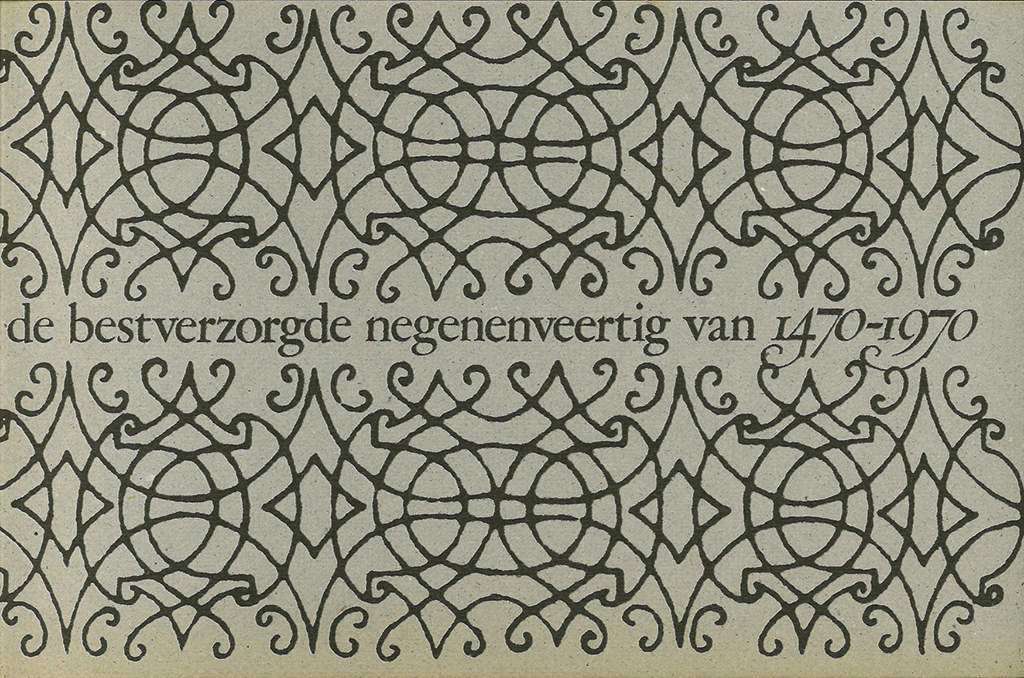
1970. Proost Prikkel (nr. 324): De bestverzorgde negenenveertig van 1470 tot 1970 (design: Bert Zijlstra)
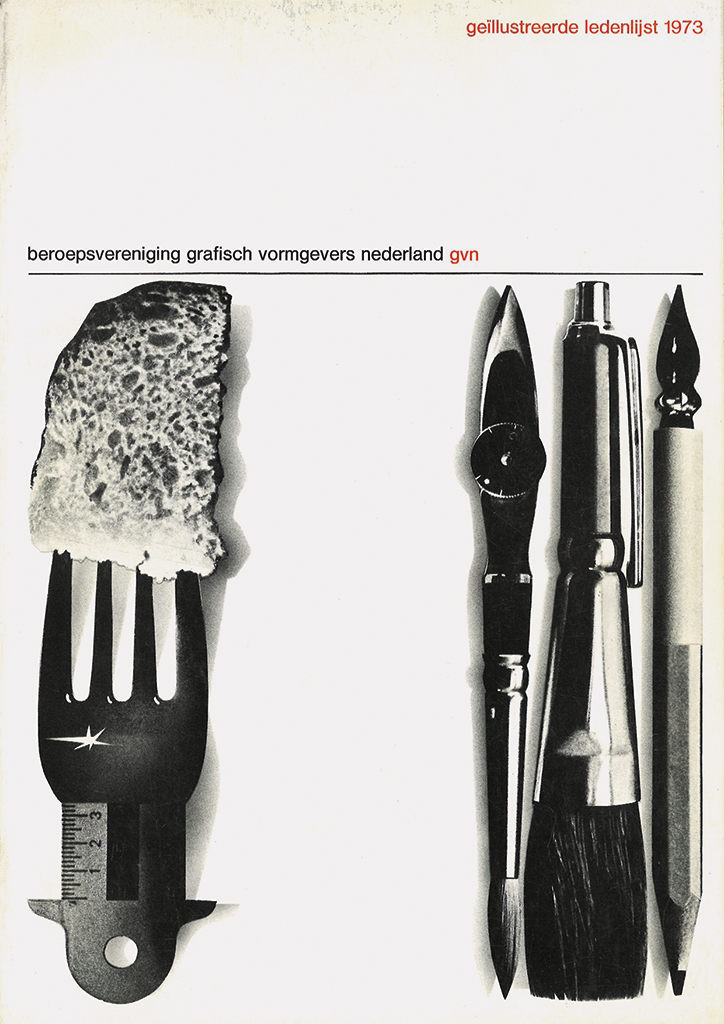
1973. Cover of GVN’s first membership register (design: Leendert van Pelt)
1970. Yocarini joins the advertising department of paper wholesalers Proost en Brandt. Proost en Brandt are already publishing their famous promotional Proost Prikkels. Titus is involved with a number of issues, one of which is the parody De bestverzorgde negenenveertig van 1470 tot 1970 (the best designed forty-nine books, 1470-1970), inspired by the abrupt end of the yearly selection and awarding of best designed books after strong critique of the organization and the adjudication process. For this issue of Proost Prikkels, forty-nine books are selected from the collection of the book museum Meermanno Westreenianum in The Hague, while texts are ‘borrowed’ from previous Best Designed Books jury reports written by Dick Dooijes. “Another idea was to publish an issue of Proost Prikkels in a watertight box to be used to grow weed. Alas, Mr. Proost himself decided this was not a good idea.” Altogether Yocarini has a great time at Proost en Brandt, not least because of the notorious annual literary ball he was able to attend.
1972. Yocarini applies for the job of director of GVN, the organization of Dutch graphic designers, and gets the job. The bureau is still housed at his predecessor René de Jong’s studio in Amsterdam North. Jantien Peeters is his assistant as the bureau finds a new location at Keizersgracht, where he creates exhibitions in the ground floor conference and exposition space, for instance of posters designed by Roman Cieslewicz, Finnish posters, and photography by Toon Michiels and Willem Diepraam. For the printer Rosbeek he edits one of their promotional publications (Om een lang verhaal kort te maken), a collection of illustrations by different GVN members, which together tell a story.
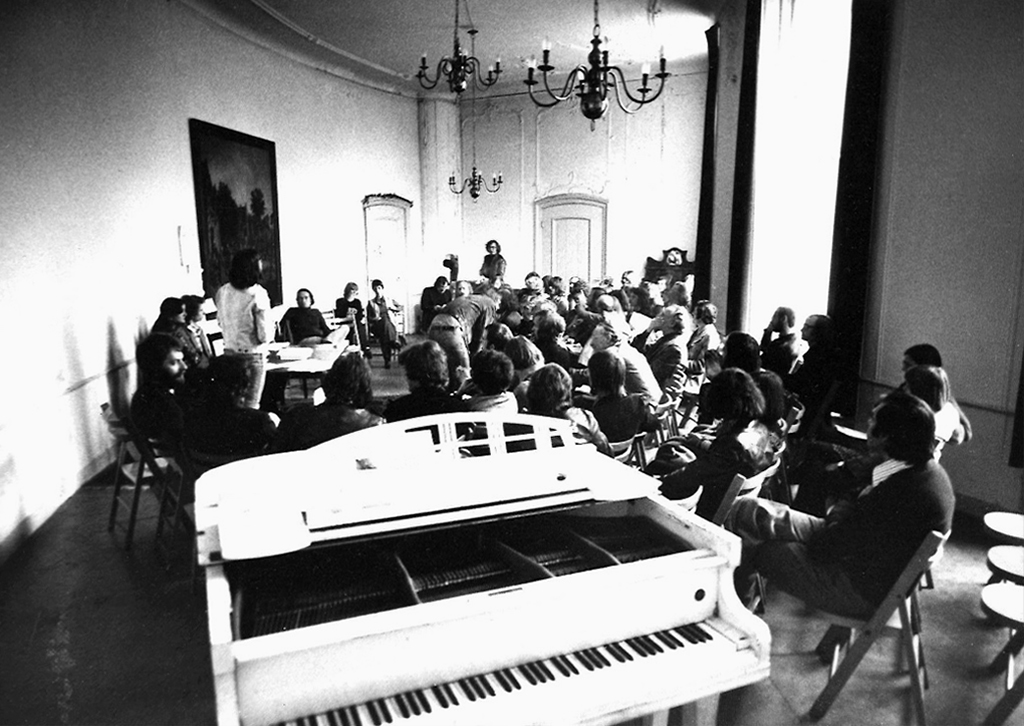
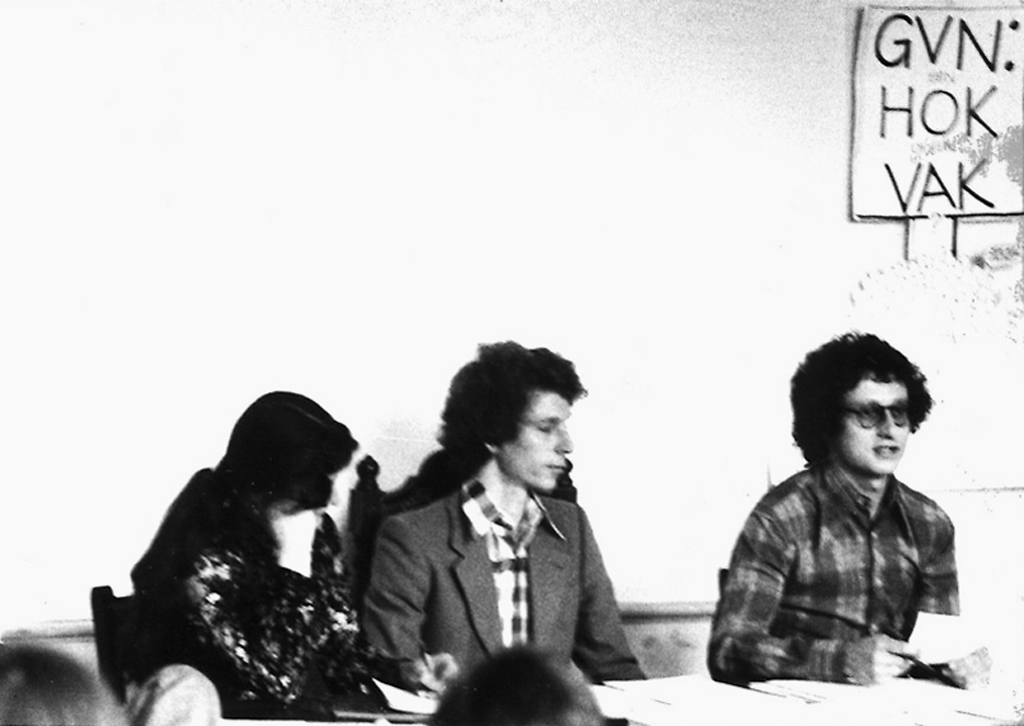
1973. GVN general meeting in Baarn: away with the ballot. From left at the board’s table: Annemarie van Gerven, Gerard Unger, Titus Yocarini
Yocarini’s first major project at GVN is the publication of their first illustrated membership register (1973). Each of the 250 members can participate by designing their own spread and having their contribution printed by their favorite printer. Steendrukkerij de Jong in Hilversum offers to take care of binding the individual contributions. The book draws attention also because it has a second side that presents the work of the members of the organization of Dutch photographers, GKf. This preludes GKf asking Yocarini to become their director next to GVN’s. In 1976, this leads to his chairmanship of the foundation that preserves the archives of photographer Maria Austria/Particam, which was established soon after Austria’s sudden demise. The foundation adds more archives and, with the help of the photographers Jaap Pieper and Bob van Dantzig, starts to provide prints from its archived collections on request. Eventually the Maria Austria Institute is founded, which preserves more than fifty archives of photographers from Amsterdam. A Yocarini initiative to study the future of photo archives eventually leads to the creation of the National Photo Archives in Rotterdam.
After the graduation of Yocarini’s partner, the two decide to make a journey by public transportation all the way to India. The journey will take approximately five months of absence from his two directorships. The GVN/GKf boards agree with finding a temporary substitute. Ton Haak, then a partner of Tel Design in The Hague, makes himself available (part time), which in the end gets him a GVN honorary membership.
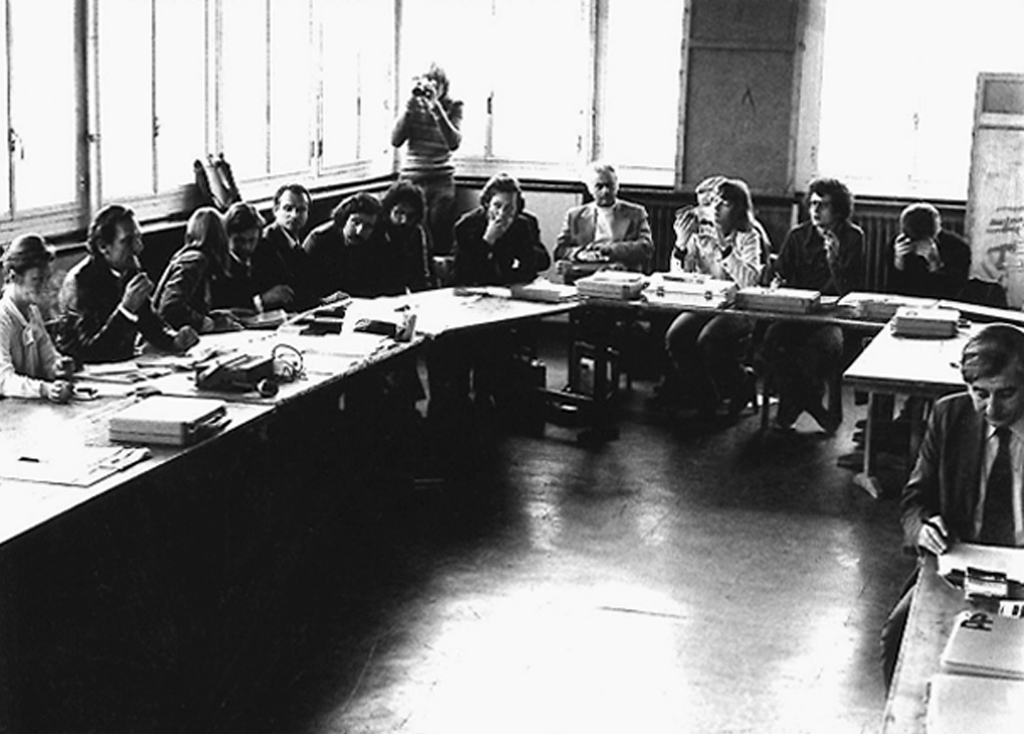
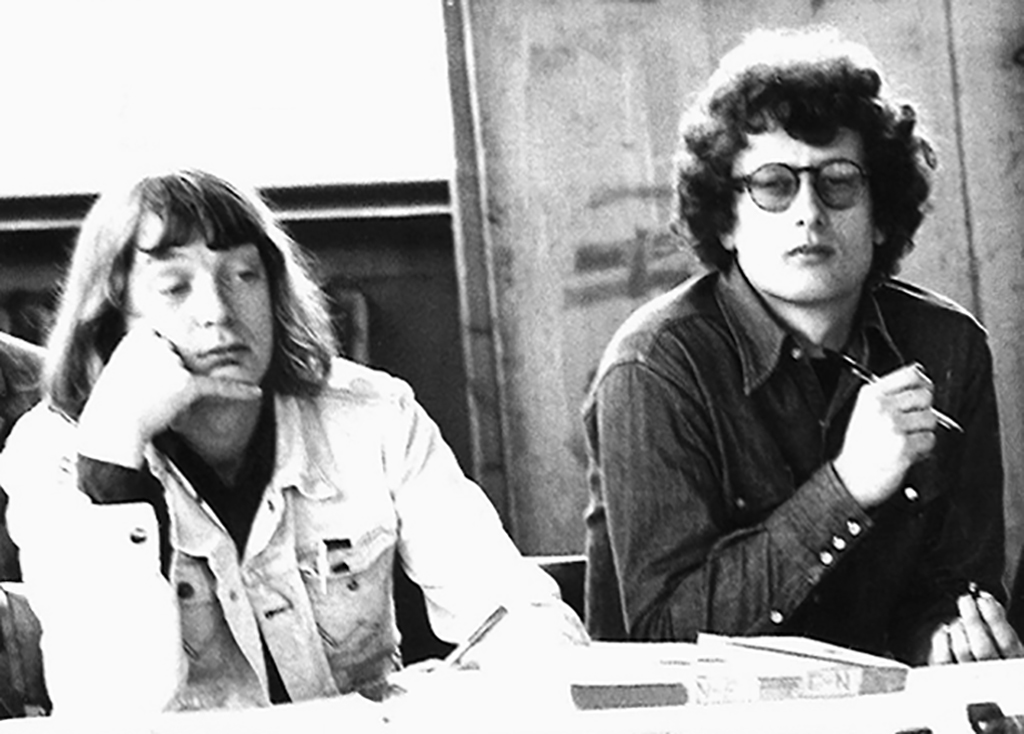
1974. Paul Mijksenaar and Titus Yocarini at the Icograda meeting in Düsseldorf
A returning debate in each and every association of professionals is: who do we allow to join. GVN, as well as its predecessors, had a history of holding a serious ballot on someone’s admission. Not just the quality of the candidate’s work was much deliberated, the aspiring member’s professional standards were weighed up as well. Yet, with the arrival of the democratization wave of the 1970s, many GVN members were of the opinion that this procedure was outdated. Yocarini, supported by Kees Nieuwenhuizen and other board members, went to work to abolish the ballot system. “It was during the general assembly that the rules were changed, but not until after a heated discussion. A few members had put up a sign that read: ‘Not a cage but a trade’.” The new rules remain in force until today: new members of the Association of Dutch Designers (BNO) must be graduates from a professional education and accept BNO’s code of conduct (called ‘code of honor’ until the late 1970s).
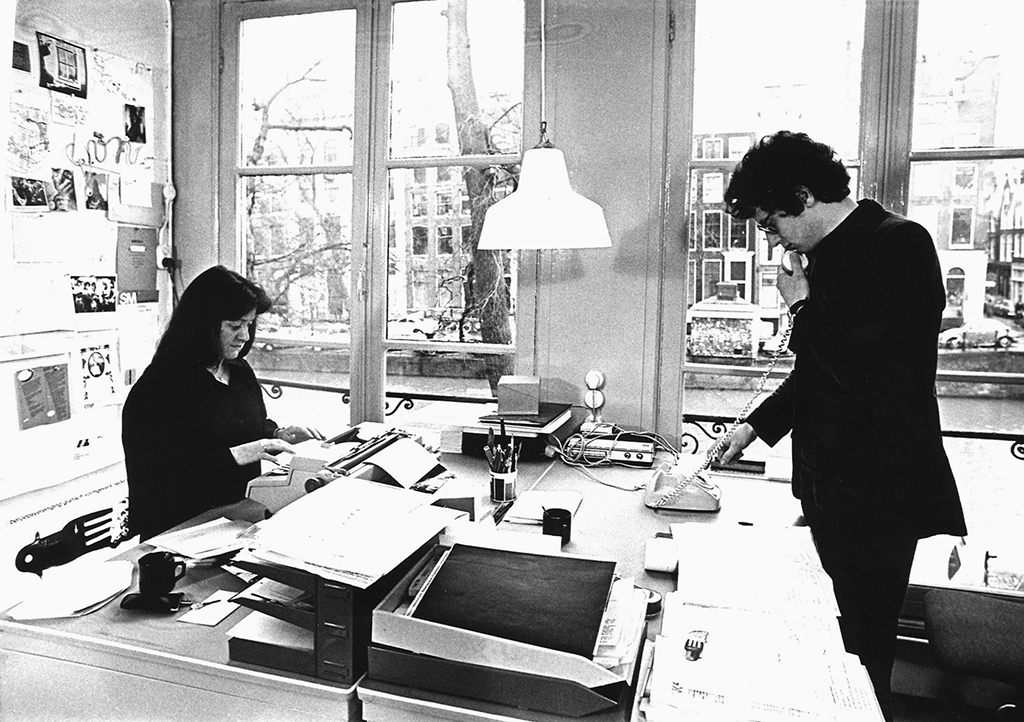
1976. GVN’s Keizersgracht office. Titus Yocarini and Annemarie van Gerven
“I was able to do many many things at GVN. The members gave me free reign most of the time. I knew everyone, thanks to attending the GVN circles that were meeting all over the country. I thought it was essential that I kept the members up to date with everything I was planning to do and with what had been discussed and decided upon in board meetings. This way, I could make a start with the first payment guidelines for designers in salaried employment. I organized a series of exhibitions of work by design students in the extension of Stedelijk Museum in Amsterdam. As a guest lecturer I informed design students about the ins and outs of working as a freelancer. And I invited many design icons such as Viktor Papanek, the author of Design for the real world, and psychologist Joycelin Chaplin to speak at meetings and to publish in GVN Bulletin.”
Early 1975. The first issue of a new design magazine, De Vorm, is published by the foundation to promote industrial design (SIV) in collaboration with all other Dutch design associations. After five issues, SIV’s funds run out. Yocarini tries to continue its publication with the help of the publishing division of SDU (State Printing House), but to no avail. In the same period, Wim Crouwel and Jan van Toorn discuss graphic design during what will become a legendary debate in Museum Fodor, Amsterdam. Yocarini tapes the heated discussion, a transcript of which will eventually be published by [Z]OO Productions in 2009.
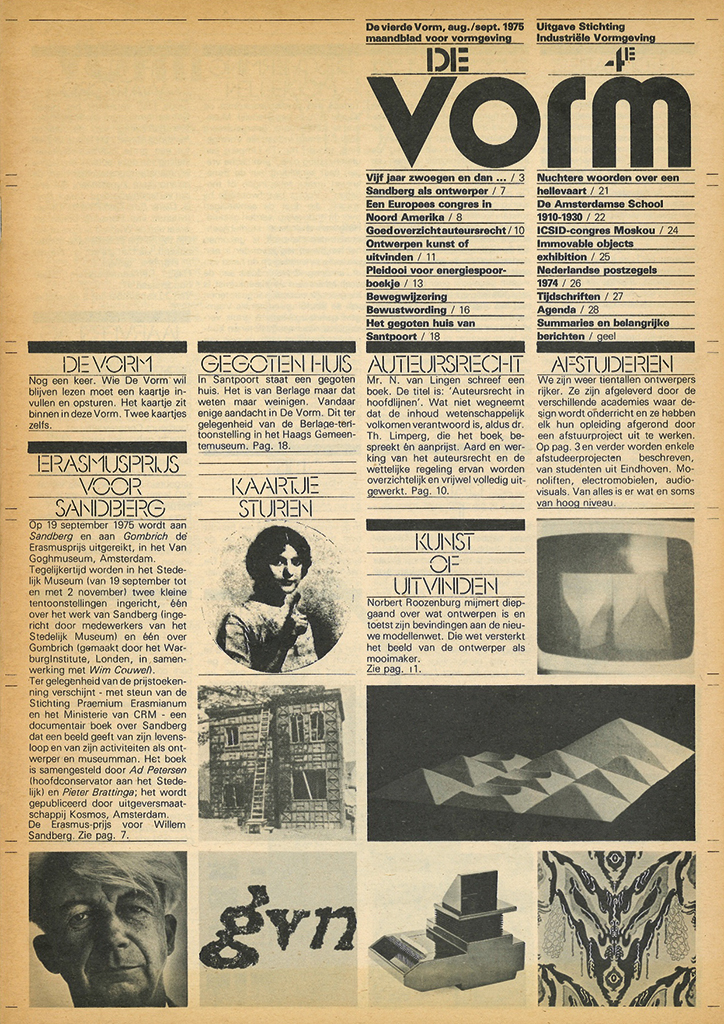
1975. Cover of the first issue of design magazine De Vorm (design: Tel Design)
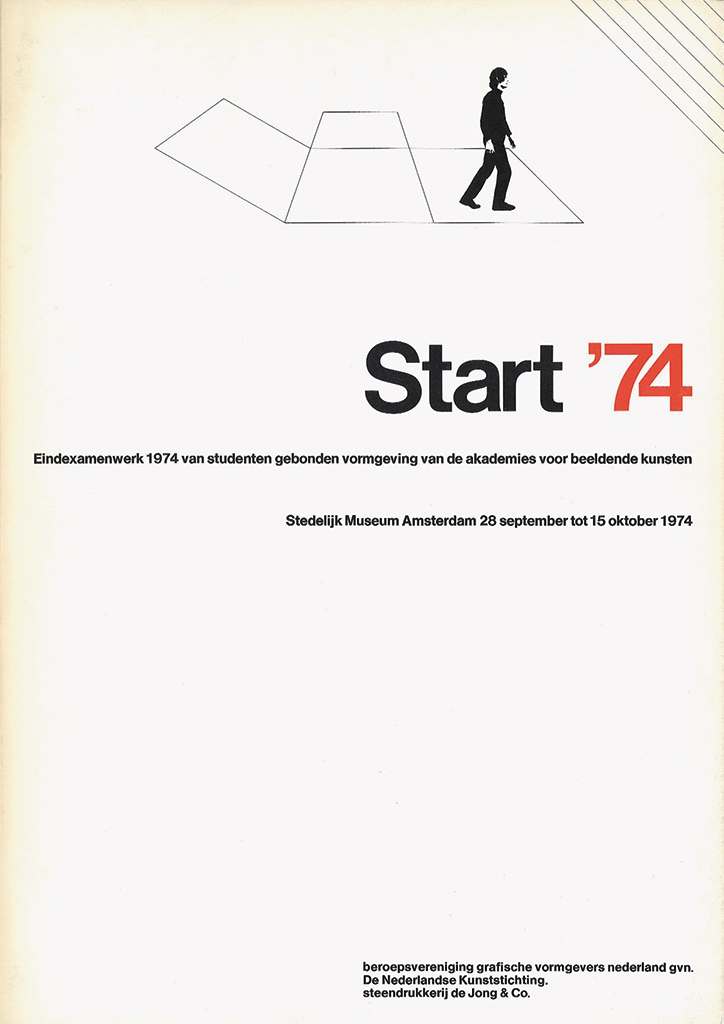
Cover of Start ’74 catalog
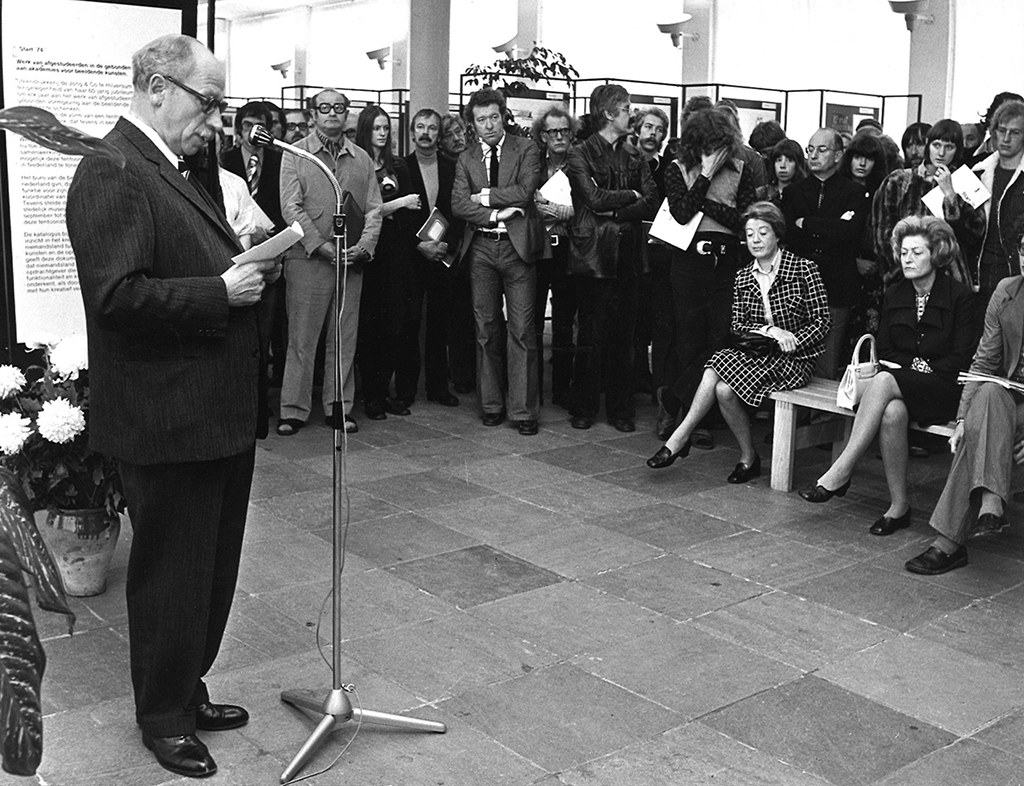
1974. The official opening, by the Minister of Culture H.W. van Doorn, of the Start ’74 exhibition in the extension of Stedelijk Museum, Amsterdam. Standing from left: Ralph Prins, Jan Vermeulen, Loek van der Sande, Tom de Heus, Gertjan Leuvelink. Sitting: mrs. Bertie Stips-van Weel, mrs. C. Van Doorn-Jager
More memorable events take place. In 1976, an exhibition on signage designed by Donald Janssen is opened in Bouwcentrum, Rotterdam; the exhibition travels to a series of locations in the Netherlands. The exhibition catalog becomes a bestseller and a collectors’ item. Many GVN members are involved with this project, curated and edited by Arthur O. Eger and Paul Mijksenaar. Also in 1976, Wim Crouwel asks Yocarini to edit an issue in the series of publications about art and design produced by Lecturis printers, Eindhoven. Yocarini’s contribution is titled: Vak in beweging (Profession in motion) and describes how the graphic design profession evolved in the Netherlands and which professional organizations played a role. It is one of the first publications to combine an art historical approach with a sociological approach of the subject. Walter Nikkels designs the publication. In 1992, by popular demand, a new and updated edition is published. The publication’s graphic design by Meevis en Van Deursen is either loved or hated; many members are of the opinion that the text is ‘unreadable’.
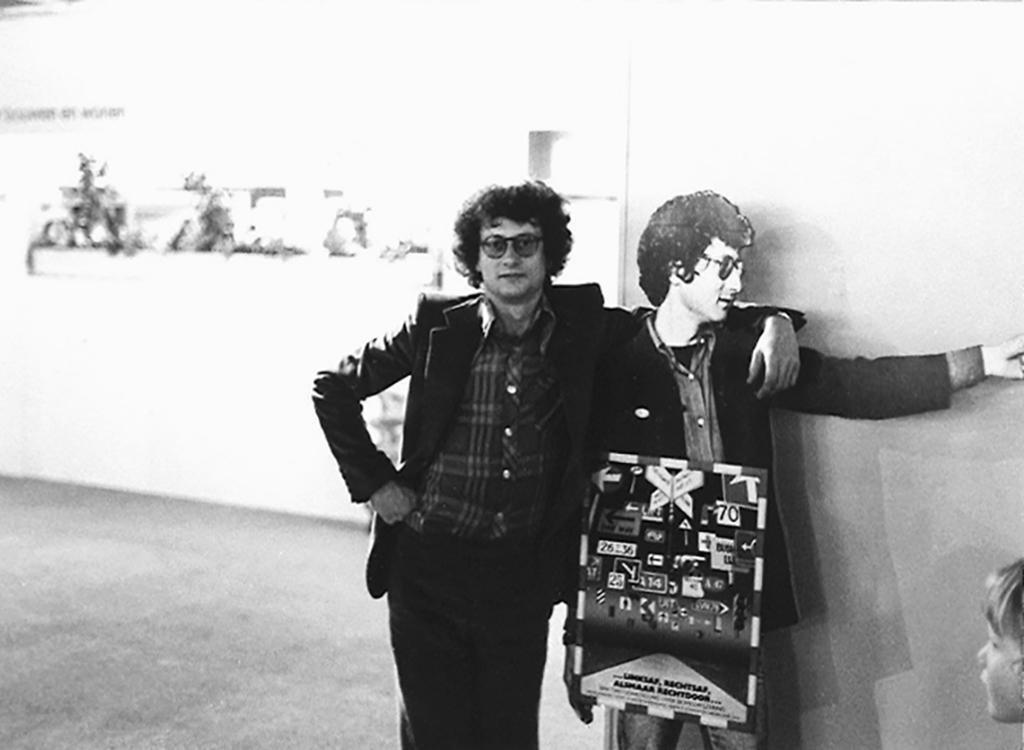
1976. Titus Yocarini at a sign with the poster for the exhibition on signage in Bouwcentrum, Rotterdam
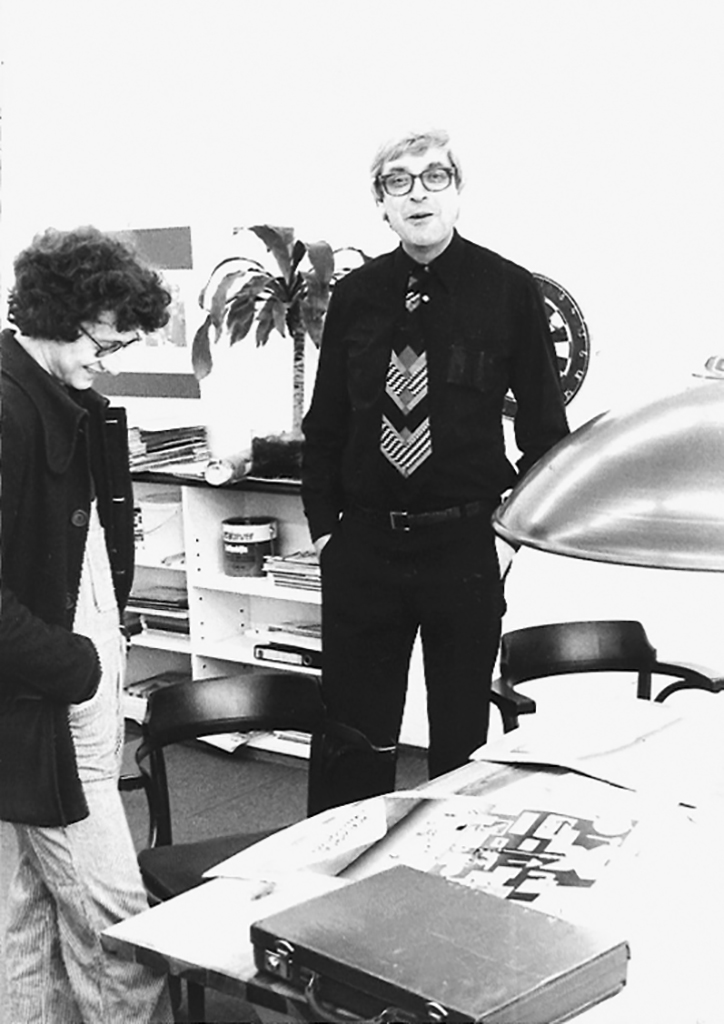
1976. Titus Yocarini and Frans Spruijt at Drukkerij Mart. Spruijt checking proofs of the poster for the exhibition on signage in Bouwcentrum, Rotterdam
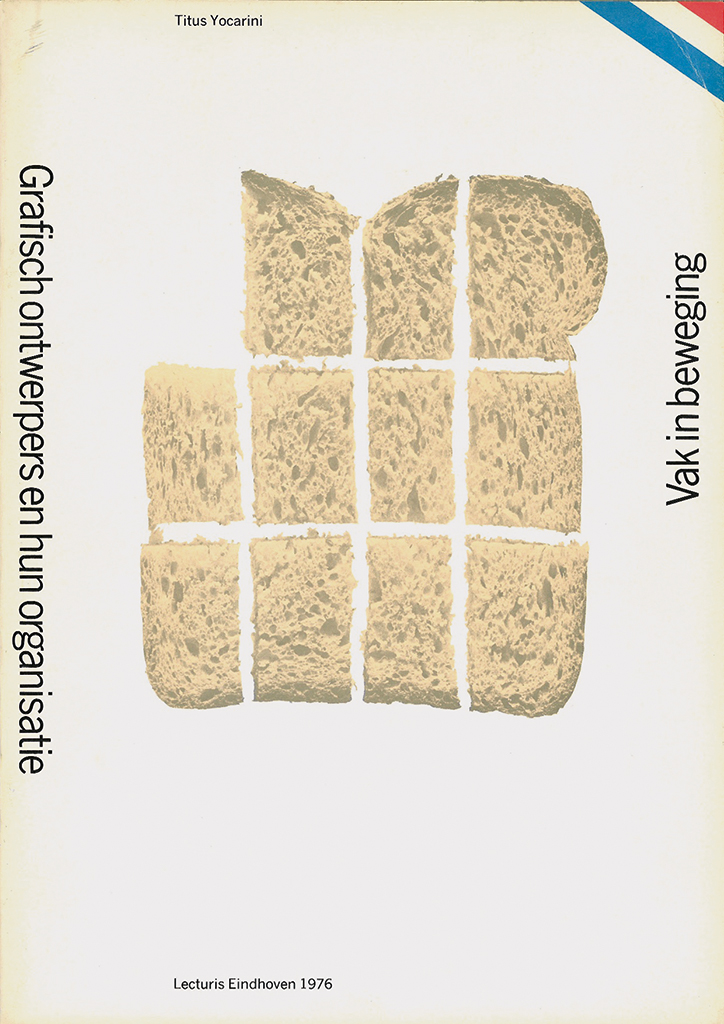
1976. Cover of Lecturis publication Vak in beweging (design: Walter Nikkels)
1979. Yocarini in collaboration with Dingenus van de Vrie and design agency 2D3D create 10 jaar designkritiek (10 years of design critique), a publication dedicated to the topical and heated dispute about ‘De Nieuwe Lelijkheid’ (The new ugly). Articles in newspapers and critical essays in magazines about this subject are brought together in this publication, in which Jurriaan Schrofer writes: “This publication deals with 10 years of design critique. As always, little analysis, no theory development, no critical distance. Or shall we say: the profession is still too young, be patient, it will come?” Yocarini will continue to collect clippings about graphic design until well into the 1990s.
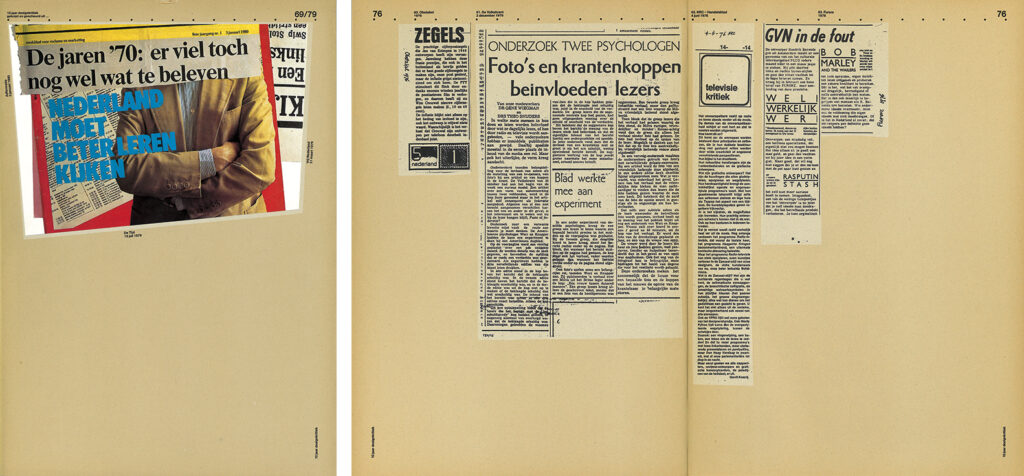
1979. 10 years of design critique edited by Dingenus van de Vrie and Titus Yocarini (design: 2D3D, Jos van der Woude)
At his departure as director of GVN, Yocarini receives an honorary membership; he will remain in touch with the profession and its organization. In 1981, he threatens to return his honorary membership if the board continues their plan to cancel GNV’s membership of the Federatie van Kunstenaarsverenigingen (Federation of Artists’ Associations) and the Voorzieningsfonds voor Kunstenaars (national fund that provides financial support to artists) in order to save money. In an open letter to all GVN members he writes: “I do not want to be an honorary member of an organization that resorts to putting on blinders only because of some financial troubles.”
Peter Brattinga had asked Yocarini to join Nico Knecht as co-manager of Steendrukkerij de Jong. Yocarini hesitated – he was still enjoying his job at GVN. Eventually he does accept, after Brattinga agrees with his proposition to add a publishing department to the printing house. Publishing books is his old dream, but he soon discovers that the financial risks are too high to realize the plans. In 1980, Steendrukkerij de Jong moves from Hilversum to a brand-new building in Amsterdam, designed by Cees Dam. Yocarini discovers old lithography blocks in the basement of the old building in Hilversum and manages to safeguard these by telling students about them, who are eager to take them.
Nico Knecht and Yocarini turn out not to be a great match. “My time with Steendrukkerij de Jong was an unsuccessful intermezzo, offset by beautifully printed books, posters and calendars, and close collaboration with graphic designers.” After two years with Steendrukkerij de Jong, Yocarini is appointed deputy director at Uitgeverij/drukkerij Gottmer in Bloemendaal, well-known for their Dominicus travel guides and a splendid list of children’s books. The arrival of a new shareholder/director, though, limits his future prospects at Gottmer. In 1982, he applies for the job of deputy director at Stichting Kunst en Bedrijf (Foundation for Art and Commerce), working under its director Ab van Yperen. A remarkable step, moving from graphic design to autonomous art, but as he says himself: “Art can be totally itself and inspire and make you think.”
Kunst en Bedrijf was founded in 1950. They are art consultants and intermediaries in the field of architecture, city planning, and the use of public space. In those years it became the rule in the Netherlands that one percent of the construction costs of new or newly acquired government buildings with a representative function must be reserved for their decoration with visual art. Kunst en Bedrijf were hired to advise on how to spend these funds wisely.
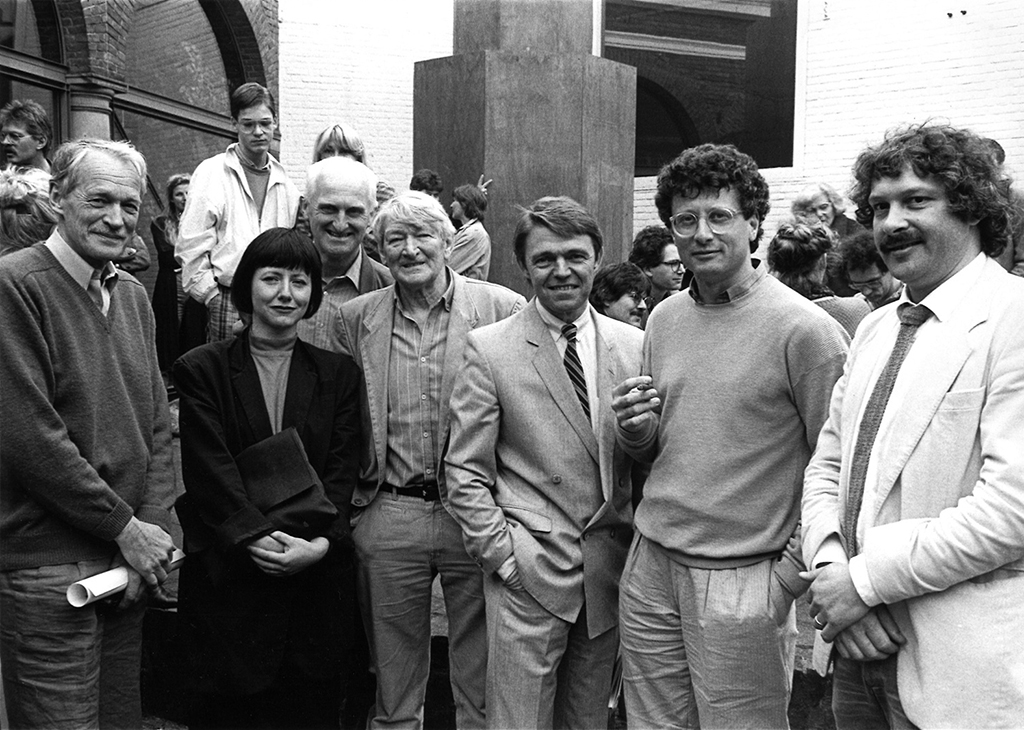
1986. Opening of the Aart Klein exhibition in De Beijerd, Breda. From left: Jan Bons, Pauline Terreehorst, Aart Klein, Cor Rosbeek, Titus Yocarini, André Swertz
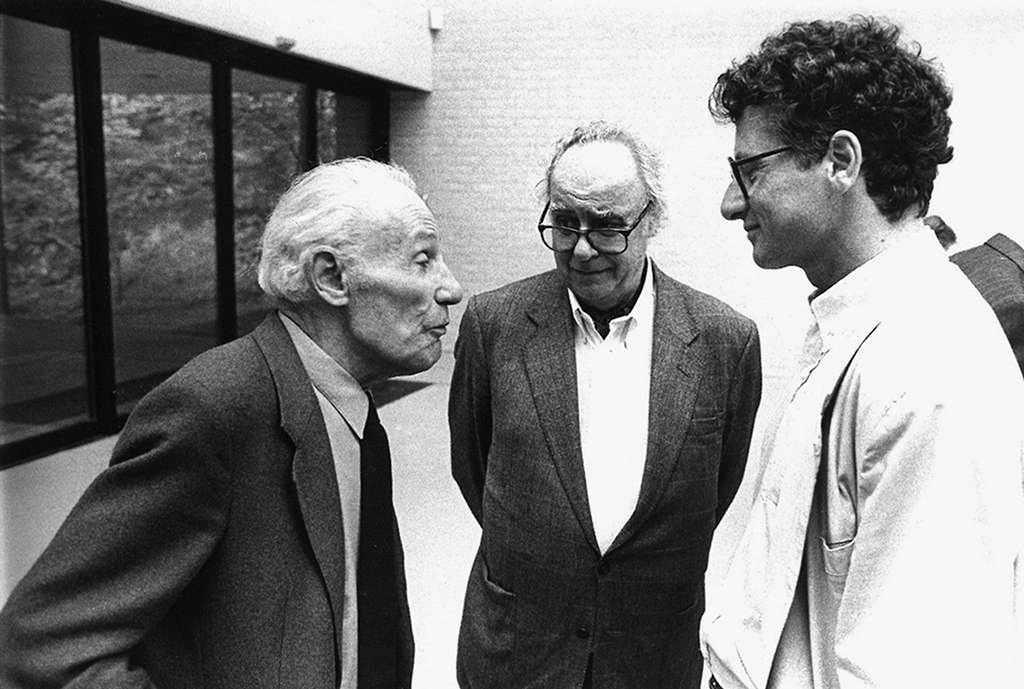
1989. Titus Yocarini with Will Bertheux, curator of Stedelijk Museum, and Gerard van de Groenekan (furniture maker of Gerrit Rietveld’s designs) at Kröller-Müller Museum
At the end of the 1980s, the government’s support for the foundation is terminated. Yocarini has succeeded Ab van Yperen as director and decides to continue even without the financial support from the government. Kunst en Bedrijf will become a limited liability company of which the shares are held by a foundation. In 1990, the company moves to Van Diemenstraat, to a building redesigned by Ben van Berkel. One year later they celebrate their 40th anniversary in Amsterdam’s Concertgebouw with an international conference on company-owned art collections.
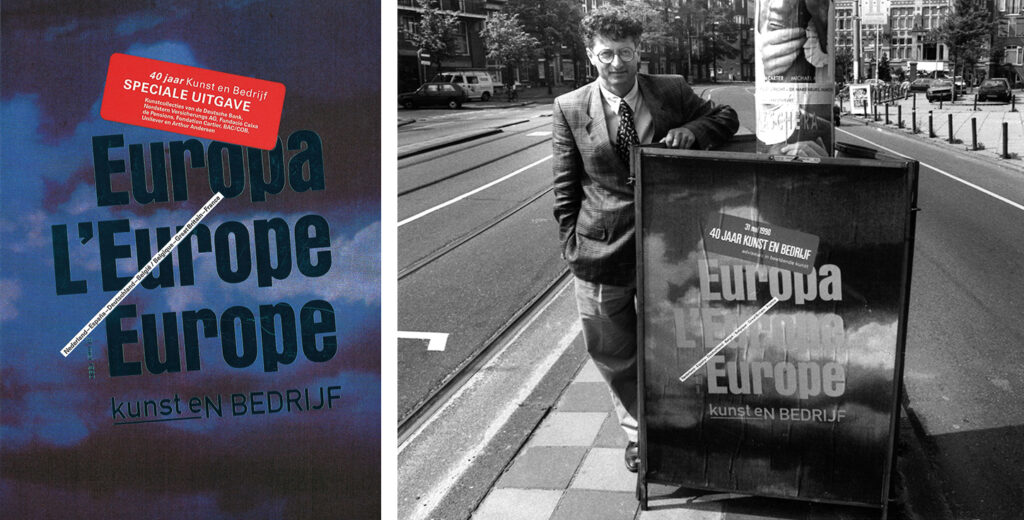
1990. Europe, a publication at the occasion of 40 years of Kunst en Bedrijf (design: Armand Mevis and Linda van Deursen). Titus Yocarini and the Europe poster, near Concertgebouw, Amsterdam
In 1995, after thirteen years of leading Kunst en bedrijf, Yocarini is ready to lead a larger organization. “My time at Kunst en Bedrijf was great, during which I gained so much love and knowledge of contemporary art. Visiting hundreds of studios, I intensively engaged with many artists and befriended many of them. I have to mention my special friendship with Marjan Unger, with whom I was able to develop an extraordinary collection of uniquely designed business gifts for commercial businesses.”
March 1995. After a magnificent farewell exhibition at Art Affairs Gallery, Yocarini moves to his new job of director of the Stichting Kunst en Cultuur Noord-Holland (Foundation of Art and Culture for the Dutch province of North-Holland). His task is to turn it into a project-based organization, something that is right up his alley, and to act as a consultant to the museums of the province. “We received great support from the provincial government and I had the opportunity to build an extensive network for the province’s art and culture. And I learned to greatly respect what the smaller museums in rural towns and villages were accomplishing.”
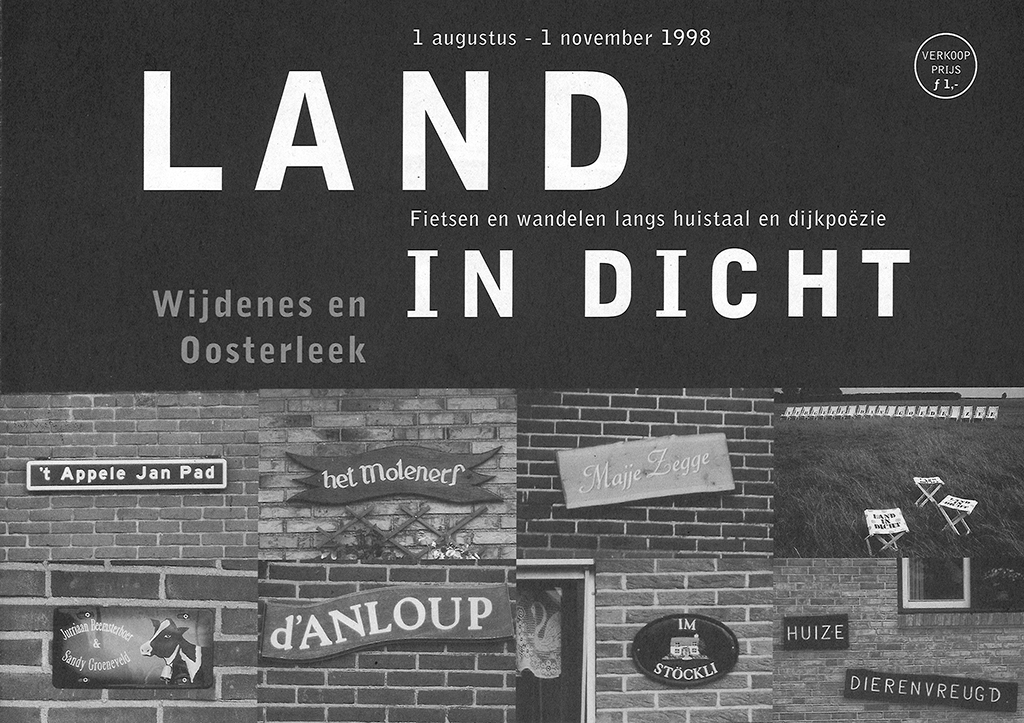
1998. Land in Dicht, poetry festival in North-Holland (design: Opera ontwerpers)
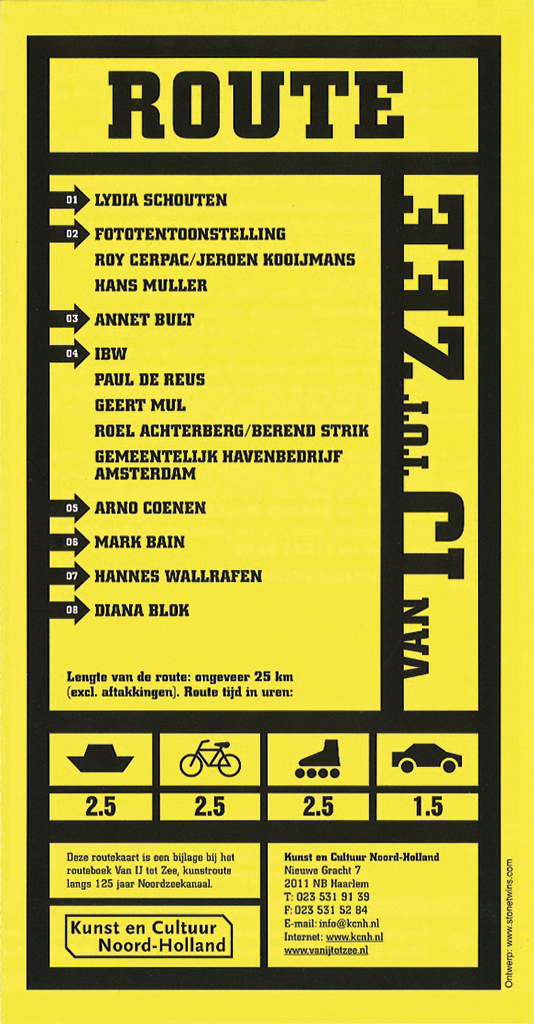
2001. Art tour Van IJ to Zee, on the occasion of 125 years of Noordzeekanaal (design: Stone Twins)
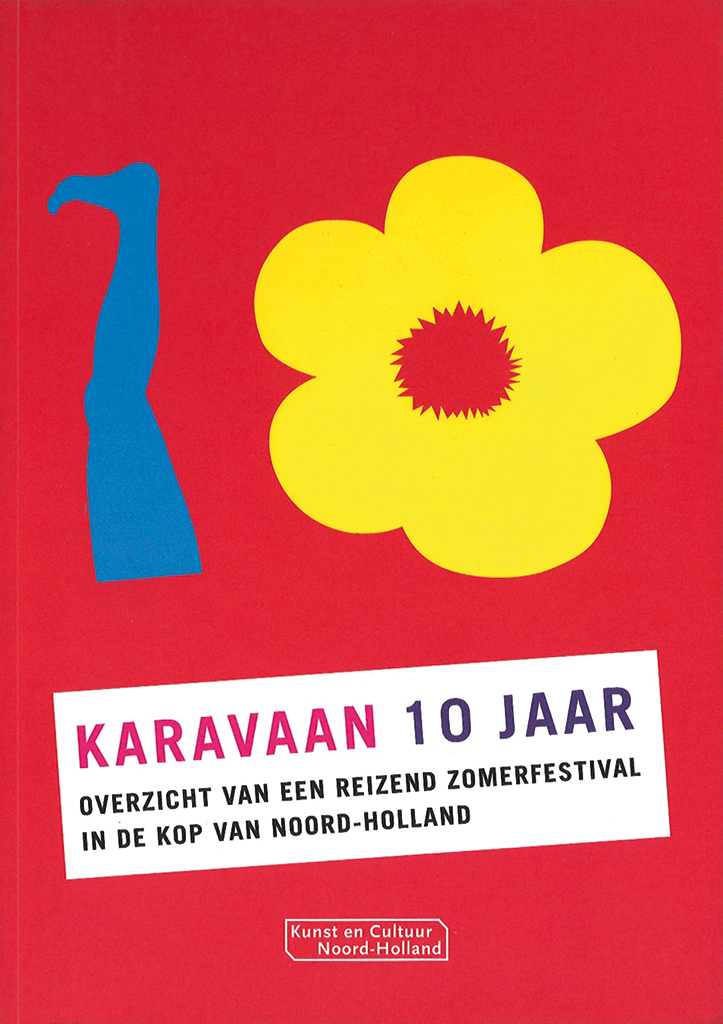
2002. Theater Festival Karavaan, 10 Years of Karavaan (design: De Designpolitie)
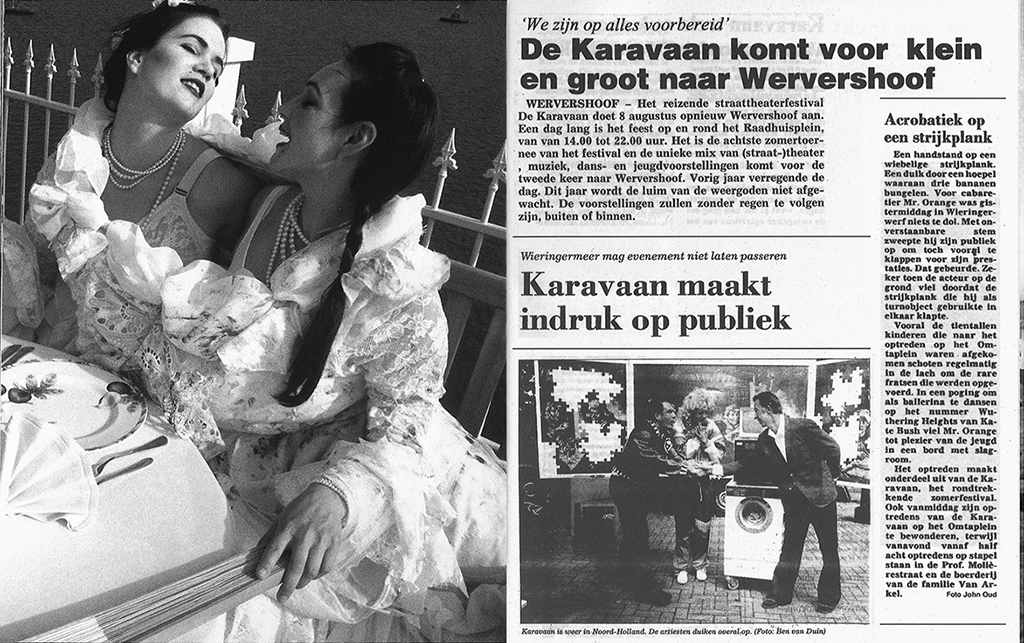
2002. Theater Festival Karavaan, book 10 Years of Karavaan (design: De Designpolitie)
In 1998, PTT Museum in The Hague became Museum of Communication. In 2004, a newspaper advertisement announces that the museum is looking for a director. Yocarini gets the job, after discussing his application with the museum board’s chairman, Wim Dik, the former head of Royal PTT Nederland. Together with his staff he manages to realize magnificent exhibitions: Het rijk van heen en weer for children; Politieke affiches (political posters); an exhibition designed by Gilian Schrofer about the relationship between the telephone and feature films; Briefgeheimen based on a book by Wim Brands; a series of exhibitions called De verleiding (The tempation) with work by Pierre Bernard, N.P. de Koo and Ootje Oxenaar; and the Privacy Project by creative agency KesselsKramer. The number of museum visitors climbs to more than 40,000 annually. Another major achievement is the website Postzegelontwerpen.nl, which presents all information about the rich history of postal stamp design in the Netherlands. The excellent museum store, presenting interesting items, is also one of his initiatives.
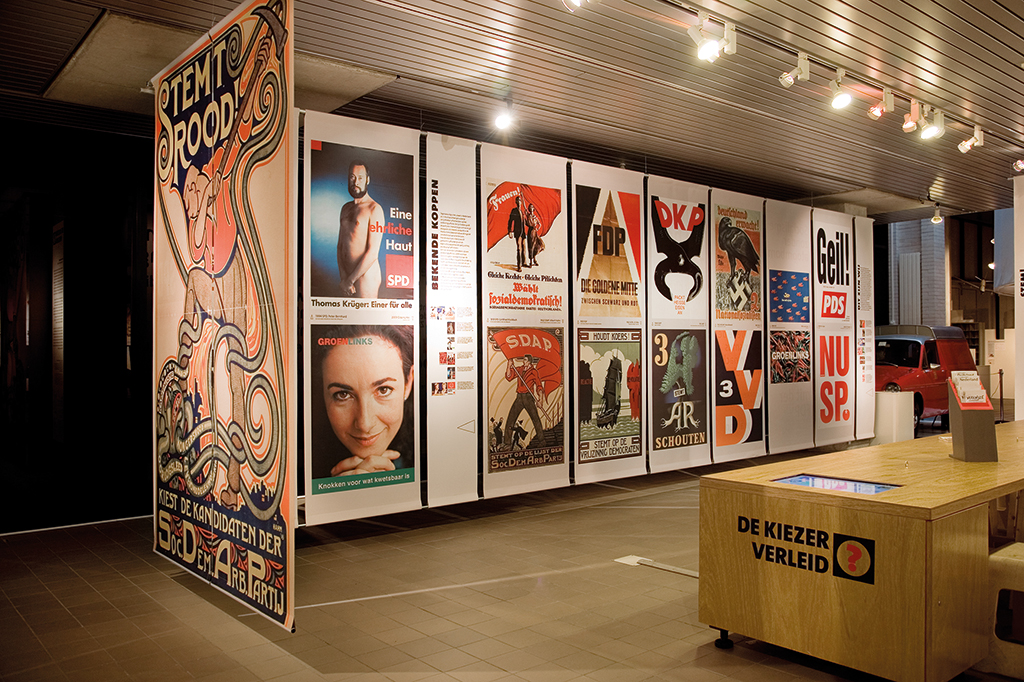
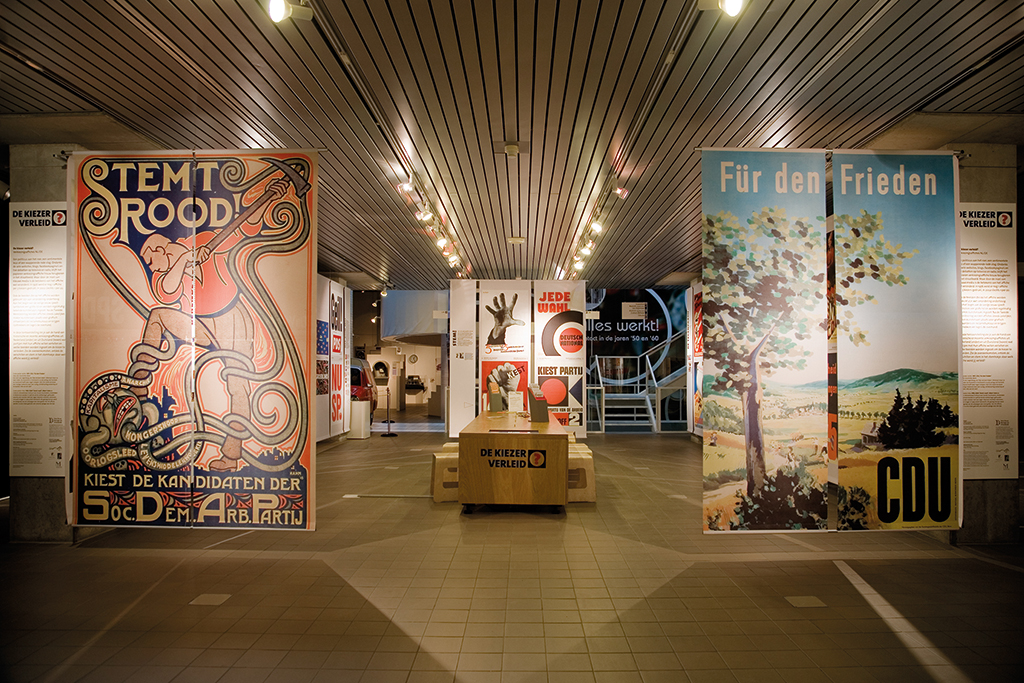
2010. Exhibition of political posters in Museum voor Communicatie, The Hague (design: Ontwerpwerk, Ed Annink)
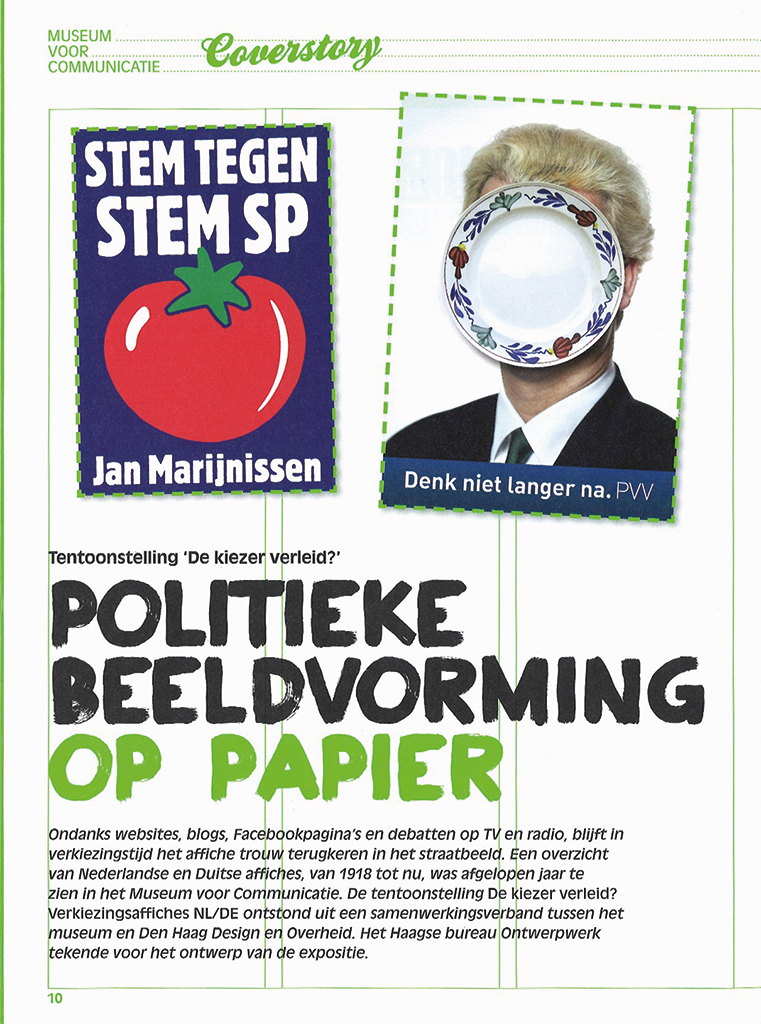
2010. Exhibition of political posters in Museum voor Communicatie, The Hague
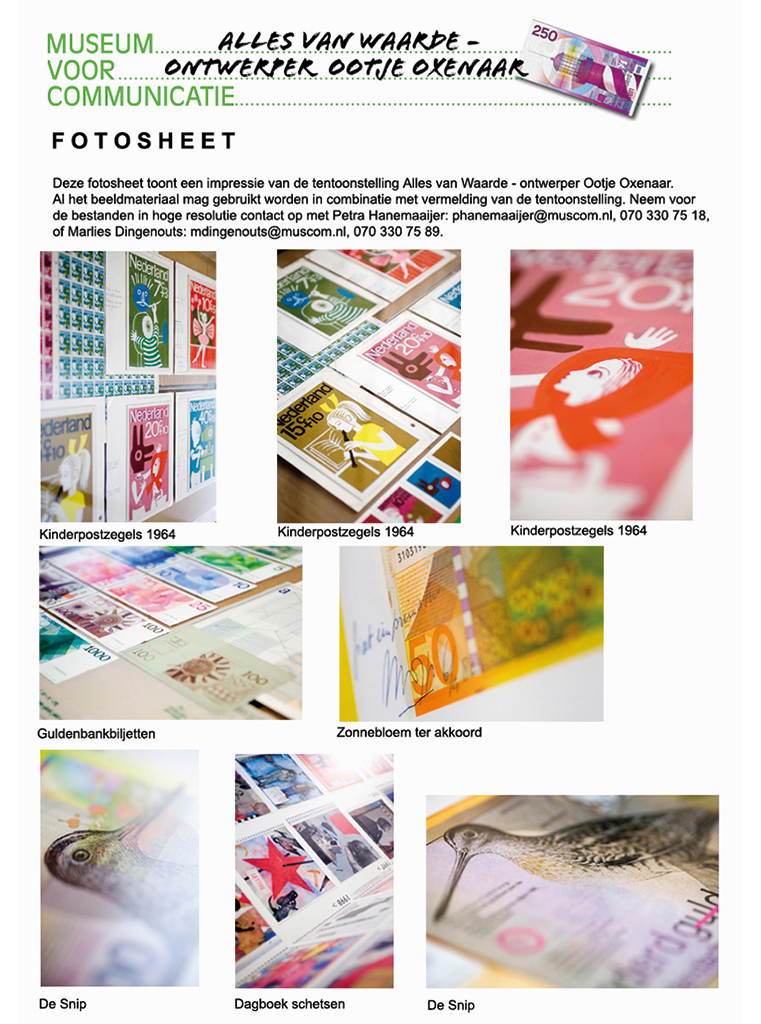
2011. Exhibition Ootje Oxenaar, Museum voor Communicatie, The Hague
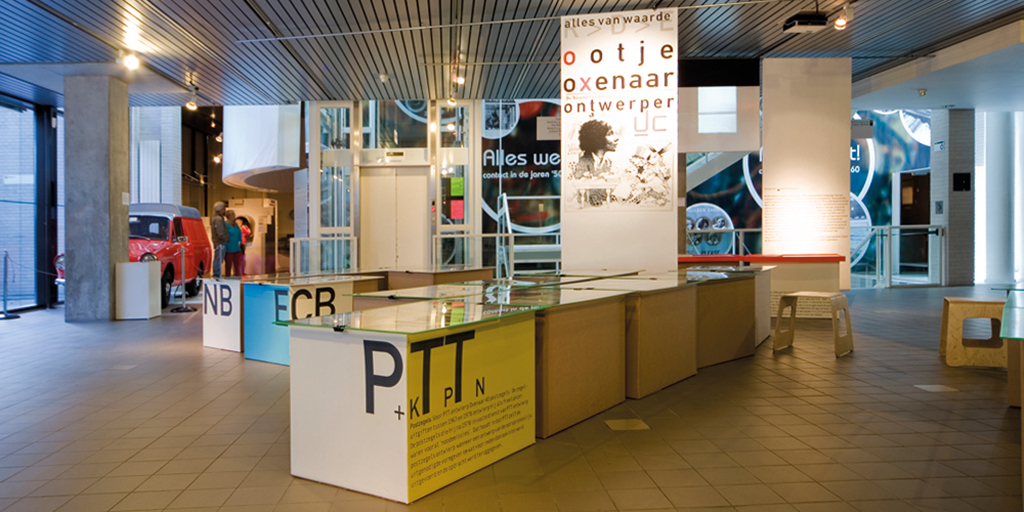
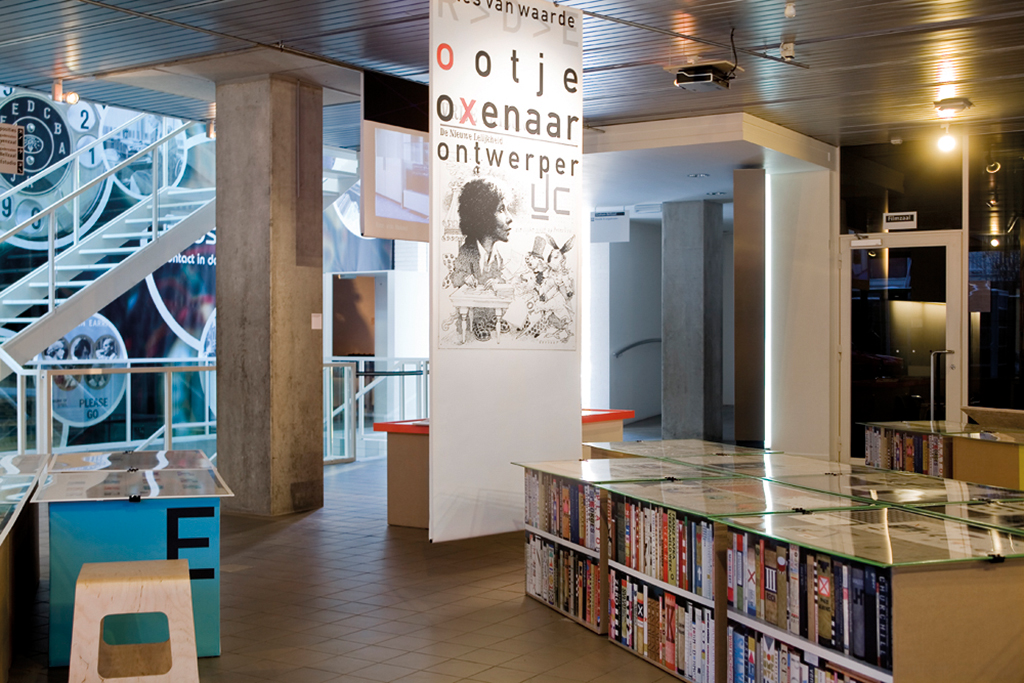
2011. Exhibition Ootje Oxenaar, Museum voor Communicatie, The Hague (design: Jan van Toorn)
2005. Tel Design’s Andrew Fallon inquires if Yocarini is willing to succeed him in the chair of NAGO, the foundation that tries to acquire, secure and open the professional archives of important Dutch graphic designers. NAGO was established in 1992 and since then managed to preserve many archives of designers and design agencies. Yocarini accepts. “NAGO was facing hard times. The government no longer gave priority to the preservation of the archives of designers and the Premsela Foundation (national design institute) and the Graphic Design Museum in Breda had also withdrawn their support.” A once-only donation from the Mondriaan Foundation gives NAGO the opportunity to acquire a few more archives, but by 2014 they can no longer continue their work. Together with Steph Scholten, the director of Bijzondere Collecties (Special Collections) of the University of Amsterdam, Yocarini takes the initiative for a new foundation, named after Wim Crouwel. The archives NAGO had the stewardship of are handed to the new Wim Crouwel Institute, which also sets to task to digitalize them and to prepare for the preservation, digitalization, and opening of all graphic design and typography archives they may acquire in the future.
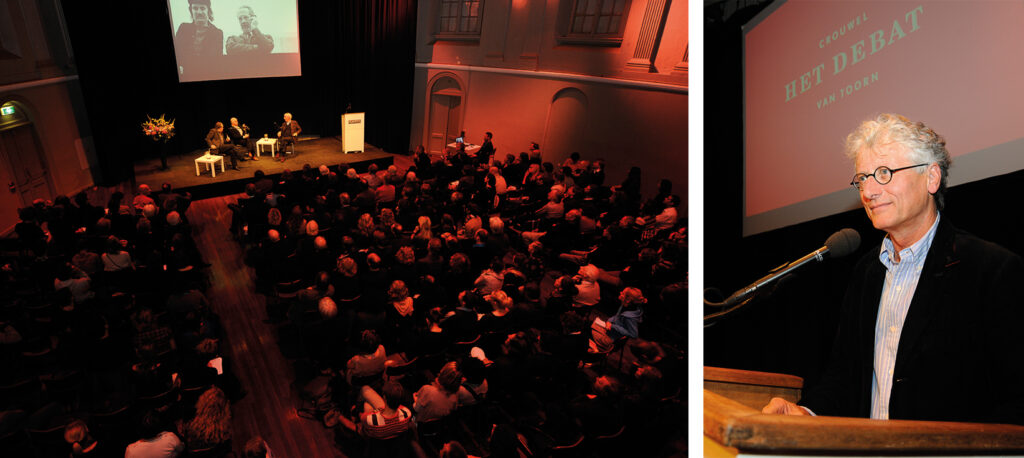
2008. Presentation in Felix Meritis, Amsterdam, of the publication Het Debat (photo: Truus van Gog/Hollandse Hoogte)
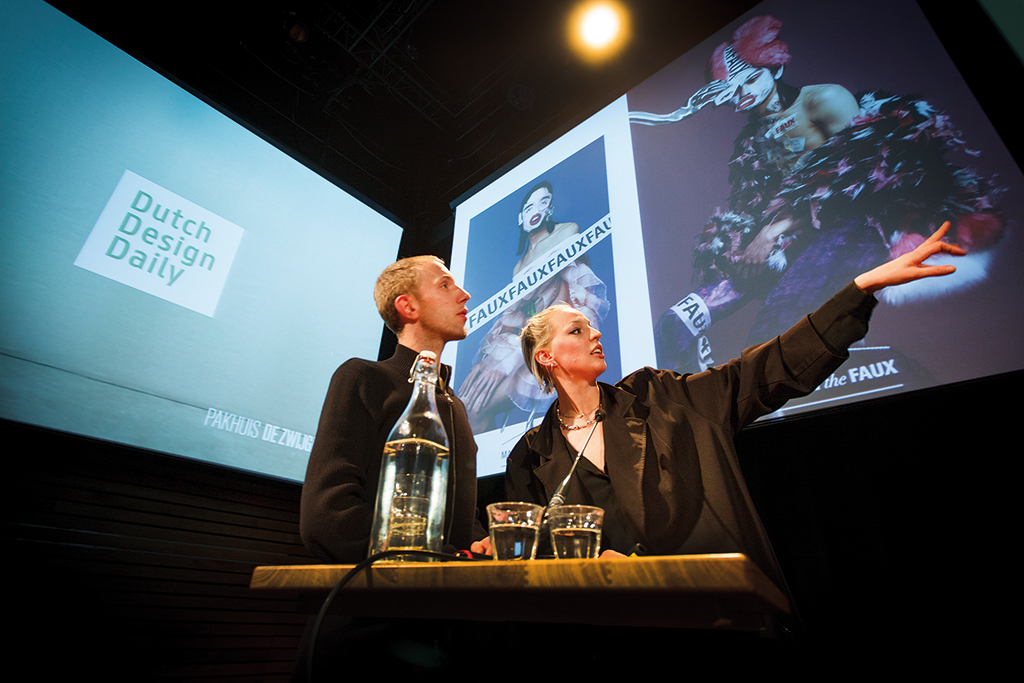
2015. Dutch Design Daily, live from Pakhuis de Zwijger, Amsterdam
Much more
Yocarini accomplished so much more. When Marc Terstroet could not find a publisher for the abstract comics he had originally created for Dutch newspaper De Volkskrant and when Jan Bons decided to return the commission to design the 1945-1985 commemoration series of postage stamps to PTT, Yocarini established Ypsilon Press. He took care that the comics came out in a book and that another publication was devoted to the design and the design process of the stamps. Yocarini is a never resting board member of the Carel Blazer Foundation, the War Memorial Foundation, and the Lucebert Foundation. He also is on the board of Dutch Design Daily, the online platform that publishes a new item every day. He keeps hammering away at the importance of realistic monetization – without bestsellers no collections of poems!
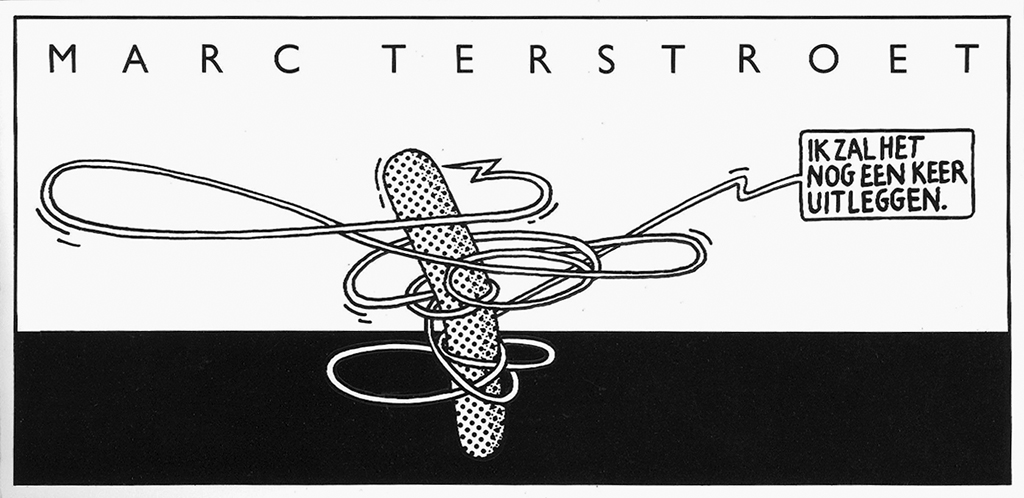
1986. Comics by Marc Terstroet, published by Ypsilon Press
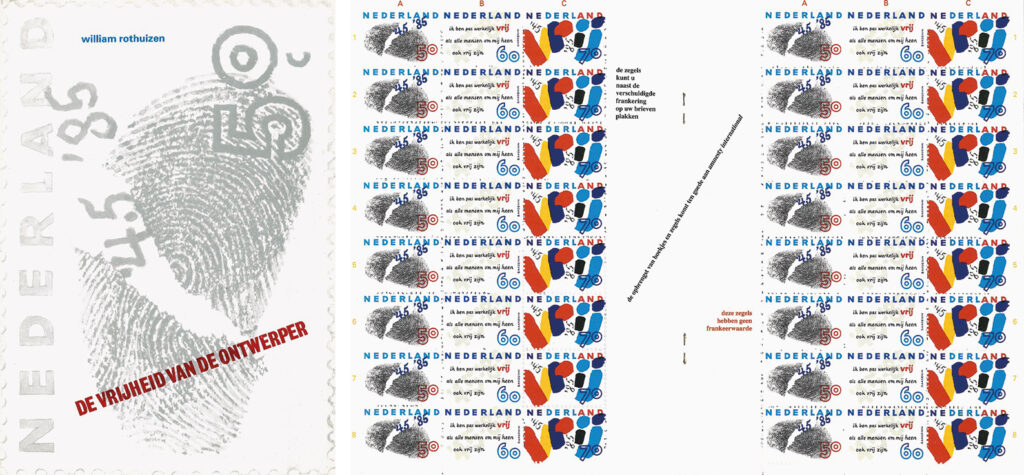
1985. Publication De Vrijheid, by Ypsilon Press, about the freedom of the designer, edited by William Rothuizen (design: Jan Bons)
Titus Yocarini
born on 17 October 1947, Amsterdam
Author of the original text: Rob Huisman, December 2016
Translation and editing in English: Ton Haak
Final editing: Sybrand Zijlstra
Portrait photo: Aatjan Renders
